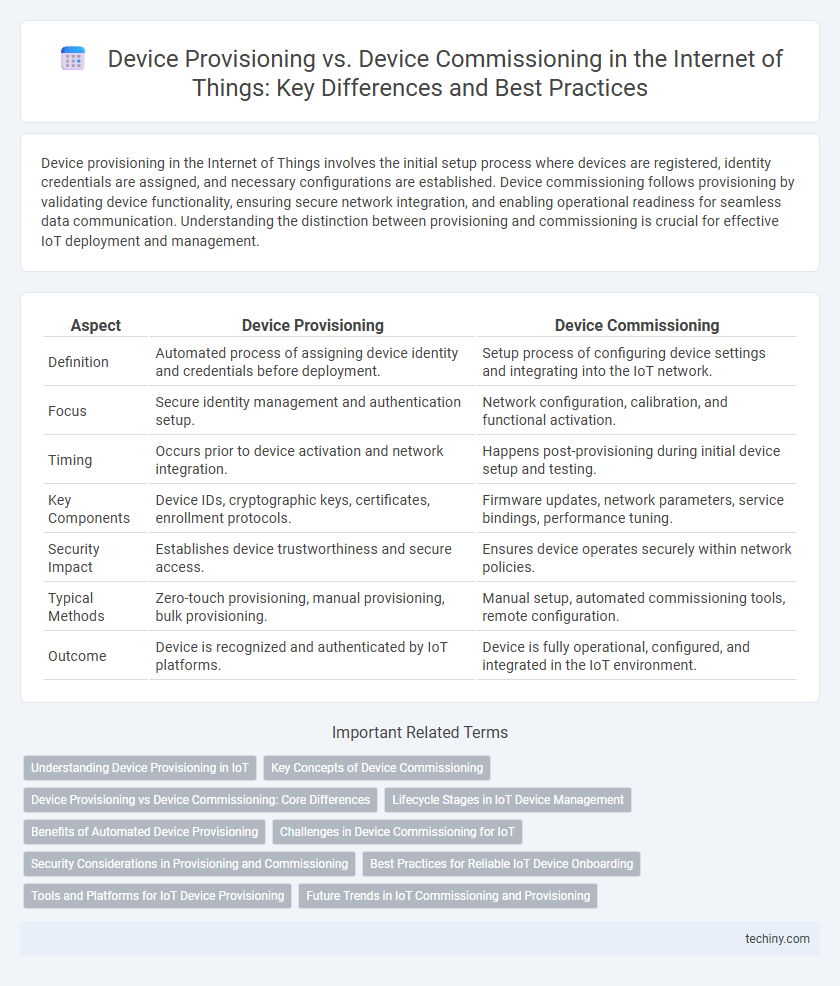Device provisioning in the Internet of Things involves the initial setup process where devices are registered, identity credentials are assigned, and necessary configurations are established. Device commissioning follows provisioning by validating device functionality, ensuring secure network integration, and enabling operational readiness for seamless data communication. Understanding the distinction between provisioning and commissioning is crucial for effective IoT deployment and management.
Table of Comparison
| Aspect | Device Provisioning | Device Commissioning |
|---|---|---|
| Definition | Automated process of assigning device identity and credentials before deployment. | Setup process of configuring device settings and integrating into the IoT network. |
| Focus | Secure identity management and authentication setup. | Network configuration, calibration, and functional activation. |
| Timing | Occurs prior to device activation and network integration. | Happens post-provisioning during initial device setup and testing. |
| Key Components | Device IDs, cryptographic keys, certificates, enrollment protocols. | Firmware updates, network parameters, service bindings, performance tuning. |
| Security Impact | Establishes device trustworthiness and secure access. | Ensures device operates securely within network policies. |
| Typical Methods | Zero-touch provisioning, manual provisioning, bulk provisioning. | Manual setup, automated commissioning tools, remote configuration. |
| Outcome | Device is recognized and authenticated by IoT platforms. | Device is fully operational, configured, and integrated in the IoT environment. |
Understanding Device Provisioning in IoT
Device provisioning in IoT refers to the process of securely registering and authenticating a device onto a network before it becomes operational, ensuring it has the necessary credentials and configurations. This step enables seamless device identity management and secure communication between the device and IoT platforms or cloud services. Proper device provisioning reduces risks of unauthorized access and ensures scalability in large IoT deployments.
Key Concepts of Device Commissioning
Device commissioning in the Internet of Things (IoT) involves the critical process of securely integrating and configuring devices within a network, ensuring proper authentication, network credentials setup, and firmware validation. This phase guarantees that IoT devices operate correctly according to predefined policies and align with security standards, reducing vulnerabilities. Unlike device provisioning, which focuses on initial device identity registration, commissioning emphasizes comprehensive device activation and readiness for deployment.
Device Provisioning vs Device Commissioning: Core Differences
Device provisioning in the Internet of Things (IoT) involves the initial setup of devices, including assigning unique identities and security credentials to ensure secure network integration. Device commissioning goes beyond provisioning by configuring devices with operational parameters, performing functionality tests, and integrating them into the management system for active use. The core difference lies in provisioning establishing a device's identity and authentication, while commissioning completes the configuration process for full device operation within the IoT ecosystem.
Lifecycle Stages in IoT Device Management
Device provisioning in IoT involves securely registering and authenticating devices onto the network during the initial lifecycle stage, ensuring devices are recognized and trusted. Device commissioning follows provisioning by configuring device settings, firmware updates, and network parameters to enable optimal functionality and integration with IoT platforms. Effective management of these lifecycle stages enhances device security, operational efficiency, and seamless scalability in IoT ecosystems.
Benefits of Automated Device Provisioning
Automated device provisioning in the Internet of Things (IoT) streamlines the onboarding process by securely registering and configuring devices at scale without manual intervention, significantly reducing human error and deployment time. It ensures consistent device identity management and secure authentication, enhancing network security and scalability. This automation accelerates time-to-market and operational efficiency while enabling seamless integration of new devices into existing IoT ecosystems.
Challenges in Device Commissioning for IoT
Device commissioning in IoT faces challenges such as ensuring secure identity authentication and establishing trust between devices and networks, which are critical to prevent unauthorized access. The complexity of configuring diverse hardware and software components for interoperability often leads to scalability issues in large IoT deployments. Moreover, maintaining firmware integrity and seamless integration with cloud platforms require robust protocols to minimize downtime and enhance system reliability.
Security Considerations in Provisioning and Commissioning
Device provisioning in the Internet of Things involves securely establishing device identities and credentials, ensuring authentication mechanisms protect against unauthorized access. Device commissioning focuses on configuring devices within the network, enforcing secure communication protocols and access controls to maintain data integrity and privacy. Both stages require robust encryption standards and adherence to security best practices to mitigate risks such as device spoofing and data breaches.
Best Practices for Reliable IoT Device Onboarding
Device provisioning in IoT involves securely registering devices on a network by assigning identities and cryptographic credentials, while device commissioning configures these devices with necessary settings to operate effectively. Best practices for reliable IoT device onboarding include utilizing automated, zero-touch provisioning methods combined with secure key management systems to prevent unauthorized access. Ensuring rigorous validation, firmware verification, and encrypted communication protocols during both provisioning and commissioning phases enhances device trust and network integrity.
Tools and Platforms for IoT Device Provisioning
IoT device provisioning involves tools like AWS IoT Core, Microsoft Azure IoT Hub, and Google Cloud IoT Core that automate device authentication, configuration, and onboarding at scale. Platforms such as DevicePilot and Particle Console provide seamless management of device identities and credentials, ensuring secure and efficient provisioning processes. Device commissioning, distinct from provisioning, typically refers to the physical installation and functional testing phase that occurs after these cloud-based provisioning steps.
Future Trends in IoT Commissioning and Provisioning
Future trends in IoT device provisioning emphasize automated identity verification and zero-touch onboarding using machine learning algorithms to enhance security and scalability. Emerging standards like IEEE 2413 and integration with blockchain technology are set to streamline device commissioning by ensuring decentralized trust management and immutable audit trails. Advances in edge computing will enable real-time device commissioning processes, reducing latency and supporting dynamic network topologies in large-scale IoT deployments.
Device Provisioning vs Device Commissioning Infographic

 techiny.com
techiny.com